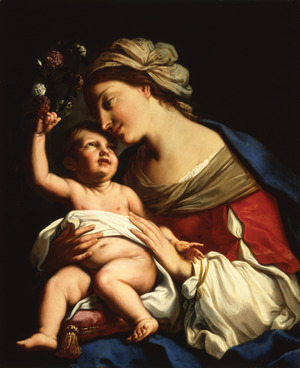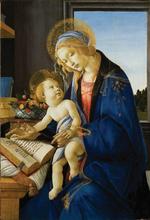An Art Show for Your Wish List
 Picturing Mary: Woman, Mother, Idea
Picturing Mary: Woman, Mother, IdeaNational Museum of Women in the Arts
December 5, 2014–April 12, 2015
Landmark exhibition explores images of Virgin Mary
by renowned Renaissance and Baroque artists
Many works on view for the first time in the United States
WASHINGTON, D.C.—Appearing throughout the entire world, her image is immediately recognizable. In the history of Western art, she was one of the most popular subjects for centuries. On view Dec. 5, 2014–April 12, 2015, Picturing Mary: Woman, Mother, Idea, is a landmark exhibition at the National Museum of Women in the Arts (NMWA) in Washington, D.C., bringing together masterworks from major museums, churches and private collections in Europe and the United States. Iconic and devotional, but also laden with social and political meaning, the image of the Virgin Mary has influenced Western sensibility since the sixth century.
Picturing Mary examines how the image of Mary was portrayed by well-known Renaissance and Baroque artists, including Botticelli, Dürer, Michelangelo, Pontormo, Gentileschi and Sirani. More than 60 paintings, sculptures and textiles are on loan from the Vatican Museums, Musée du Louvre, Galleria degli Uffizi, Palazzo Pitti and other public and private collections—many exhibited for the first time in the United States.
 “Among the most important subjects in Western art for more than a millennium was a young woman: Mary, the mother of Jesus. Her name was given to cathedrals, her face imagined by painters and her feelings explored by poets,” said exhibition curator and Marian scholar Monsignor Timothy Verdon, director, Museo dell’Opera del Duomo, Florence, Italy. “This exhibition will explore the concept of womanhood as represented by the Virgin Mary, and the power her image has exerted through time, serving both sacred and social functions during the Renaissance and Baroque periods.”
“Among the most important subjects in Western art for more than a millennium was a young woman: Mary, the mother of Jesus. Her name was given to cathedrals, her face imagined by painters and her feelings explored by poets,” said exhibition curator and Marian scholar Monsignor Timothy Verdon, director, Museo dell’Opera del Duomo, Florence, Italy. “This exhibition will explore the concept of womanhood as represented by the Virgin Mary, and the power her image has exerted through time, serving both sacred and social functions during the Renaissance and Baroque periods.”
Picturing Mary presents images of Mary as a daughter, cousin and wife; the mother of an infant; a bereaved parent; and the protagonist in a rich life story developed through the centuries. The exhibition and accompanying catalogue reflect the project’s ecumenical approach, offering new views of Mary through a range of contemporary art-historical perspectives.
Picturing Mary is the newest project in an ongoing program of major historical loan exhibitions organized by NMWA, including An Imperial Collection: Women Artists from the State Hermitage Museum (2003) and Royalists to Romantics: Women Artists from the Louvre, Versailles, and other French National Collections (2012). In addition to illustrating the work of women artists, NMWA also presents exhibitions and programs about feminine identity and women’s broader contributions to culture. Picturing Mary extends, in particular, the humanist focus of Divine and Human: Women in Ancient Mexico and Peru, a large-scale exhibition organized by NMWA in 2006.
Picturing Mary: Woman, Mother, Idea is organized by the National Museum of Women in the Arts with the support of MondoMostre, Rome. The exhibition is made possible with multiple sponsorships including an indemnity from the Federal Council on the Arts and the Humanities.
Exhibition Highlights
Picturing Mary will offer insight into the manner in which both female and male artists conceptualized their images of Mary. The exhibition features the work of four women artists: Sofonisba Anguissola, Artemisia Gentileschi, Orsola Maddalena Caccia and Elisabetta Sirani.
“Although women artists during the Renaissance and Baroque periods were expected to focus on still life or portraiture, Picturing Mary demonstrates the intriguing ways in which women artists engaged with the narratives and symbolism that developed around the subject of Mary,” said NMWA Director Susan Fisher Sterling. “Both female and male artists contributed to the rich and varied visualization of Mary in these periods.”
In one of the earliest works in the exhibition, Puccio Capanna, a student of Giotto, depicted an enthroned Mary as Queen of Virgins. She is surrounded by female saints, a grouping that alludes to Mary’s position as a model of virtue and faith for all women. Early regal depictions of Mary prevailed until the concept of Mary as an approachable, empathetic persona began to take hold in medieval monastic communities.
Fra Filippo Lippi’s Madonna and Child (1466–69) was made for the influential Medici family, patrons of the arts who helped foster the Italian Renaissance. The artist’s image of Mary reveals wealthy Florentines’ desire for a Madonna who reflected their own lives: the Virgin is dressed in a rich brocade gown and a head scarf trimmed with gold and pearls. The mother and child’s touching cheek-to-cheek pose first appeared in Florentine sculptures of the same period.
Picturing Mary offers the first opportunity to see two mid-15th-century works by northern Italian artist Cosmè Tura side by side. A painting of the Madonna and Child on loan from the National Gallery of Art in Washington, D.C., and a related terracotta relief attributed to Tura from the Grimaldi Fava Collection in Italy both depict the Virgin with elongated fingers and a wide forehand. These deliberate distortions were meant to signify Mary’s spiritual intensity.
Sandro Botticelli’s Madonna and Child (1480–81) depicts Mary and Jesus in a domestic setting as Mary reads from a book of prayers. Her melancholy expression and the darkening sky beyond the window suggest Mary’s premonition of Christ’s death. Botticelli was favored by the leading aristocratic families of Florence and enjoyed the patronage of Pope Sixtus IV.
Considered the most important woman artist before the modern period, Gentileschi was the first woman to run a large studio with many assistants and was also the first woman follower of Caravaggio. Her life story has inspired a number of contemporary novels and films. Gentileschi’s Madonna and Child (1609–10) depicts Mary as a nurturing peasant woman. With Jesus wrapped in a plain cloth and a barefooted Mary wearing simple, everyday clothes, Gentileschi presents a markedly humble conception of the Virgin.
Sirani’s Virgin and Child (1663), part of NMWA’s collection, portrays Mary not as a remote queen of heaven, but rather as a very real young Italian mother. She wears a turban favored by Bolognese peasant women and gazes adoringly at her plump baby. When Sirani died at 27, she had already produced two hundred paintings, drawings and etchings. She became famous for her ability to paint beautifully finished canvases so quickly that art lovers flocked to her studio to watch her work. Her portraits and mythological subjects, especially her images of the Holy Family and of the Virgin and Child, gained her international fame.
Online Exhibition
In conjunction with the physical exhibition, NMWA is presenting an online exhibition, featuring global representations of Mary, including the Virgin of Guadalupe and Black Madonnas from Europe and the Caribbean. In addition, NMWA has partnered with MapHook, a location-based journal and social networking application, on an interactive program that will enable a global audience to trace the route of exhibition works arriving from major international museums and learn more about them.
Publication
A 160-page, full-color catalogue published by NMWA and Scala Arts Publishers will accompany the exhibition; it features four essays and one hundred color images. The essays, by Monsignor Verdon; Melissa R. Katz, Luther Gregg Sullivan Fellow in Art History, Wesleyan University; Amy G. Remensnyder, professor of history, Brown University; and Miri Rubin, professor of medieval and early modern history and head of the School of History at Queen Mary University of London, deepen the ecumenical approach of NMWA’s Picturing Maryproject, offering an expansive view of historical Marian art. The central essay, by Monsignor Verdon, discusses works in the exhibition and provides an incisive view of Mary through both socio-historical and theological lenses. Essays by historians Amy G. Remensnyder and Miri Rubin situate Mary within the broader social context of European history. Remensnyder centers her discussion on the Virgin Mary as a key player in encounters between Christian and Muslim nations in the medieval and Renaissance eras. Rubin surveys Christian traditions of representing Mary (including those developed in monastic communities) and their influence on political and cultural realms. Including discussion of a sculpture type known as Vierge ouvrante, in which the Virgin’s body serves as a set of doors that open to reveal other motifs, art historian Melissa R. Katz considers the devotional function of Marian imagery and the remarkable fluidity of its meaning through time. The catalogue will retail for $45.
National Museum of Women in the Arts
Founded in 1981 and opened in 1987, NMWA is the only museum solely dedicated to celebrating the achievements of women in the visual, performing and literary arts. The museum’s collection features 4,500 works from the 16th century to the present created by more than 1,000 artists, including Mary Cassatt, Frida Kahlo, Alma Thomas, Lee Krasner, Louise Bourgeois, Chakaia Booker and Nan Goldin, along with special collections of 18th-century silver tableware and botanical prints.
NMWA is located at 1250 New York Avenue, NW, Washington, D.C., in a landmark building near the White House. It is open Monday–Saturday, 10 a.m.–5 p.m. and Sunday, noon–5 p.m. For information, call 202-783-5000 or visit nmwa.org. Admission is $10 for adults, $8 for visitors 65 and over and students, and free for NMWA members and youths 18 and under. Free Community Days take place on the first Sunday of each month. For more information about NMWA, visit nmwa.org, Broad Strokes Blog, Facebook or Twitter.
Image Credit Lines
Sandro Botticelli (Alessandro Filipepi), Madonna and Child (Madonna col Bambino), also called Madonna of the Book (Madonna del Libro), 1480–81; Tempera and oil on wood panel, 22 7/8 × 15 5/8 in.; Museo Poldi Pezzoli, Milan; inv. 443
Elisabetta Sirani, Virgin and Child, 1663; Oil on canvas, 34 × 27 1/2 in.; National Museum of Women in the Arts, Washington, D.C., Gift of Wallace and Wilhelmina Holladay; Conservation funds generously provided by the Southern California State Committee of the National Museum of Women in the Arts
